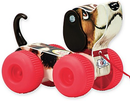|
Cross posted from www.joeys.foundation/blog  When starting to work with any child, I want to build rapport, trust, and create a working relationship. The Greenspan Floortime Approach™, based on the work of Dr Stanley Greenspan, encourages parents and therapists to meets a child where he or she is at and build on innate strengths and abilities. We do this by creating a warm relationship and engaging in back and forth interactions. The adult expands on the interactions to include as many senses, motor skills, and emotions as makes sense in the play context. The Greenspan website states “As you do all this, while staying within his focus, you are helping him practice basic thinking skills: engagement, interaction, symbolic thinking and logical thinking. To master these skills requires using all these senses, emotions, and motor skills” Joey and I built the foundations of our relationship around a modern remake of a vintage floppy eared “Little Snoopy” dog toy. When you pull on his rope, he comes rolling fast to your side on his wheels. Joey showed some initial interest in the toy and using high affect, interesting sounds, and funny songs we built further interest and motivation with the toy. With this back and forth engagement I was able to observe how Joey was mobile (mostly by rolling to his desired place and/or object). After observing his base level of mobility, I felt a combination of NDT (Neurodevelopmental Treatment) and Floortime would be the appropriate approach for the strongest gains. We will address more of what NDT entails next week. If you are looking to use a Floortime approach some engagement game ideas provided by our friend Lindsey Schucker, M.A., CCC-SLP include:
Remember that the purpose of these games is to increase your child’s ability to sustain pleasurable interactions with you. If the game is no longer pleasurable for your child, decrease the challenge, take a break, or transition into a new game. Be aware of your child’s preferences regarding touch. Do not engage in games that require you to tickle or grab them if they don’t like it. Finally, remember that you are acting as a play partner – avoid being directive (unless necessary to maintain safety).
3 Comments
4/7/2023 07:47:52 am
I wanted to express my gratitude for your insightful and engaging article. Your writing is clear and easy to follow, and I appreciated the way you presented your ideas in a thoughtful and organized manner. Your analysis was both thought-provoking and well-researched, and I enjoyed the real-life examples you used to illustrate your points. Your article has provided me with a fresh perspective on the subject matter and has inspired me to think more deeply about this topic.
Reply
4/7/2023 09:22:38 am
I wanted to express my gratitude for your insightful and engaging article. Your writing is clear and easy to follow, and I appreciated the way you presented your ideas in a thoughtful and organized manner. Your analysis was both thought-provoking and well-researched, and I enjoyed the real-life examples you used to illustrate your points. Your article has provided me with a fresh perspective on the subject matter and has inspired me to think more deeply about this topic.
Reply
Leave a Reply. |
AuthorMs Amy has 10 years of experience as an OT and believes in educating the community to empower parents and teachers to recognize the difference between typical and atypical development and sharing creative ideas to facilitate age appropriate skills. She wants to be a resource for children and families of all abilities. Archives
February 2021
Categories |
 RSS Feed
RSS Feed